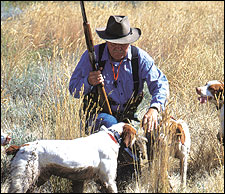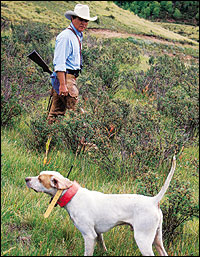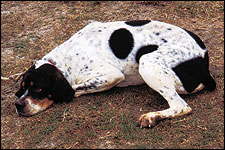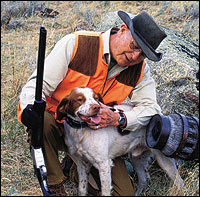Correction at home or in the field is touchy business.
By Charles F. Waterman
 Working dogs in groups tends to prevent crankiness according to many hunter-trainers. |
Crime and punishment are part of the bird dog business, the punishment sometimes being worse than the crime. A long time ago I chased some quail with a fellow who carried a chain for disciplinary purposes. It was a bigger chain than you'd believe and it was used as a switch. I guess he'd learned just how hard to swing it for I saw no cuts. Minor bruises, of course, would be hard to find on a pointer or setter.
I watched apprehensively and he never hit a dog while I was with him. On one occasion he made ominous clickity-clack noises with the chain and I confess that a big English pointer obviously took note of the sound. I impolitely asked the man if he hit his dogs very often and he said he didn't have to. Said you had to be pretty firm until they got the idea, after which you could slack off. When he addressed a slightly wayward dog he used language indicating he did not come from a cloistered background.
Long before I had heard of an electric collar for dog training, I went to see a famous retriever handler in hope of learning something about his training methods. I found he was working dogs on a secluded little lake and when I got out of the car and started walking I got on the wrong trail and accidentally came to a spot where I could watch him and his string of dogs without being seen. In a stroke of impolite stupidity I decided to observe for a while in silence.
With whistle and voice he worked retrievers through complicated retrieves such as win trophies, and he rewarded good performances with congratulations, friendly pats and an occasional bit of some kind of dog food. Then he came to a prospect that simply refused to follow instructions and he brought out an electric cattle prod that caused the stubborn dog to give out agonized bawls, but it still refused a rather complex pair of retrieves. More cattle prod and more howls and I wished I was somewhere else, having no desire to walk up to a famous trainer who was obviously abusing one of his charges. Apparently that prod was really hot and I could have sworn the dog didn't know what it was supposed to do, but after I thought its spirit was crushed the offender performed the retrieves smoothly, received pats and a hug and wagged happily. The trainer loaded up his charges and drove off, leaving me standing unseen in mud and brush, a little uncertain as to what I had watched. This is not a defense of cruelty but an admission that it has sometimes worked.
The modern electric collar has come a long way, capable of delivering everything from punishment to congratulation. The first one I owned was pretty simple in design and I learned accidentally that I was in a state where sale of electric collars was illegal. I got my first one to give pause to a wild-eyed English setter, who, like a young baseball — pitching prospect, had "plenty of speed but poor control." Sometimes the collar put out a little more jolt than I should have used, I now believe after all these years.
A friend of mine borrowed that first collar to handle a bullheaded rascal who ignored yells and thought whistles were encouragement. (Note that I am not naming breeds or bloodlines to avoid accusatory letters). Anyway, the rebel was not stupid, figured where the electricity was coming from, and would charge his owner, who eventually trained him while wearing a leather jacket and welder's gloves. Of course, in its beginning, most electricity was simply punishment, long before the electric collar became a complete training program. The owner of some champion retrievers told me he got out of the game because the training required too much "rough stuff." And I am not picking on the retriever people. It's simply a fact that "hands on" correction can be used a lot in training for retriever trials.
The tough part of deciding on proper punishment for canine misdeeds involves the character of the individual dog and sometimes runs to low comedy--as in the case of the really good Brittany who insisted on chasing jackrabbits.
 The electric collar is much in evidence as this pro handler gently works a young pointer. |
Now a jackrabbit in cruising gear can leave most bird dogs far behind and I am positive there are few Brittanys capable of making a jackrabbit extend himself. But my pride and joy would do his best, inserting a frantic yip now and then as he fell behind his quarry. An elderly bird hunter explained to me that in "correcting" an errant dog it was desirable to have the punishment fit the crime exactly. He said that when the dog chased a rabbit I should shoot the rabbit and swat the dog with it. Of course, a dog — chased jackrabbit tends to make a circle and come back to the place he was in the first place. When my dog chased a healthy jack around a hill I waited for the return and shot the rabbit when it came back--with the dog still far behind somewhere and trying to work out the trail. The dog panted up to me, saw and scented the dead rabbit and was delighted when I whacked him with it, obviously feeling it was the pinnacle of his hunting career. I've told the story uncounted times but it's still a perfect example of making the punishment fit the crime--even if it didn't work.
Of course, the first rule of punishment is to be sure the dog knows why his ear is pinched or his electric collar is a little sharp. And speed is important, especially difficult in the case of a runaway. By the time you catch him he may not feel punishment has anything to do with his deer chase or far-extended cast. And I recall seeing a hunter cuff a dog as he loaded up after a long day of questionable operation. He might as well have given him a sandwich.
There's more dog shooting than is commonly believed. It's a barbaric practice all right, but long before electric collars it was a means of getting to a transgressor from a distance, often an instant after the dog did something wrong. It's happened more around quail shooting than anywhere else, I think, simply because the shot is small and unlikely to be fatal. There have been hunters who carried special ammunition for the purpose--light loads they thought were unlikely to do serious damage. It's pretty obvious that almost any size of shot is capable of putting out an eye at considerable range and there have been those cases in which just a pellet or two killed a dog by getting into important vitals. Veterinarians can tell you stories of X-rays that showed ounces of "correctional" bird shot just under the skin, and I knew a professional biologist of all people who regularly shot dogs that didn't perform as they should. The victim may not suffer extreme pain but he's in danger.
Ear-pinching (not pulling) can be a fairly mild correction. Professional handlers often carry whips and learn to use them even for minor corrections. I guess a greenhorn with too much whip and a bad temper should be handcuffed. Yanking a dog by the collar can get pretty rough although when he's on a lead some brisk tugs can get his attention without harm. Once in a while somebody steps on a dog's toes but that's touchy business.
Of course, punishment must fit both the crime and the dog. I have seen dogs simply quit hunting when somebody got cranky with them, despite the popular opinion that the hunting is bred in and can't be worked out. I was out with a man who seemed to be very gentle with his dogs, but when a female pointer refused to come in he whistled sharply at her and yelled pretty loudly--about the way I would have. The pointer left.
 Nobody abused this young pointer but intense training caused him to suddenly give up, temporarily at least. A trainer said he was "just confused" and needed to take it easy for a while. It worked out. |
"Well, there she goes!" he said grimly. "No telling when I'll see her again!"
He didn't see her again for days. That particular dog would simply run away when she thought she had been abused and her owner had found her in several different kennels. Once he paid a considerable amount to get her back. I guess you'd call that a kidnapping. Now you understand, he had simply bawled her out.
There was no physical abuse and I have no idea of how such a situation could be corrected. He ran several pretty good dogs, partly on horseback and partly on foot. I've known plenty of dogs that were likely to simply run away but that was the only one I have known that took off simply because she was bawled out a little and whistled at. She found birds and pointed well but I sure wouldn't want that much of a prima donna. Don't know what finally became of her.
Now and then there is an otherwise acceptable pointing dog that eats birds instead of retrieving them. It happens most often in quail country because small birds are easy to gulp and I knew one miscreant you had to race to every kill. Last I saw of him his owner had pretty well given up. Once the bird was down the hatch it was pretty hard to figure appropriate measures. Ear pinching and switching didn't seem to fit the crime and the dog always looked puzzled instead of penitent. There was the real fear that if you used an electric collar carelessly you'd kill the retrieving instinct. Correcting mistakes during actual pointing and backing gets complicated. I had a pointer that refused to back, simply stealing the other dog's point, and if the other dog crowded him he'd shove it out of the way and take over if he could get away with it. I've seen him go 50 feet to rough up what he considered a competitor. Careful use of an electric collar worked but it was touchy business.
An old friend named Manon Halcomb used some very good English pointers on quail, and he had one dog who would point and then run behind his boss while the shooter or shooters walked up. Halcomb said the dog had figured that was the only place he could be sure of not doing something wrong. While I watched that performance I concluded that it's possible for dogs to be too smart. And now and then you'll find one who does something he obviously expects to be punished for but figures the fun, food or frolic was worth it.
 A little one-on-one discussion in the field calms a youthful Brittany. |
Years ago I had a Brittany who was prone to run away from home for short periods. We lived near numerous neighbors and when he was on the lam our Brittany apparently visited various backyards and dog pens. He may have sought females but it appeared he was just out for casual visits. He'd come back in an hour or two and seemed to accept a switching as part of the routine. In slipping away he could take advantage of every bush and tree but when he came home he did so openly, apparently feeling he'd get a switching no matter how he handled it. These were daylight trips.
Once I guess I was in a really bad humor and swatted him hard enough that he yipped, whereupon a neighbor lady came over and told me to take it easy. She was right, of course. The dog suddenly looked abused and I had become a heel.
Delayed punishment is generally useless or worse, even though some dogs are aware they have broken the rules. It's very easy to show favoritism if you're running two or more. A dog that fouls up frequently regularly gets the short end and I have seen some that obviously felt inferior and acted it. Anyway, for better or worse, most of us show favoritism when we deal with more than one dog. Some of those getting the short end of attention don't mind at all. Some will sulk. Some of them become followers instead of leaders and seem to like it that way.






